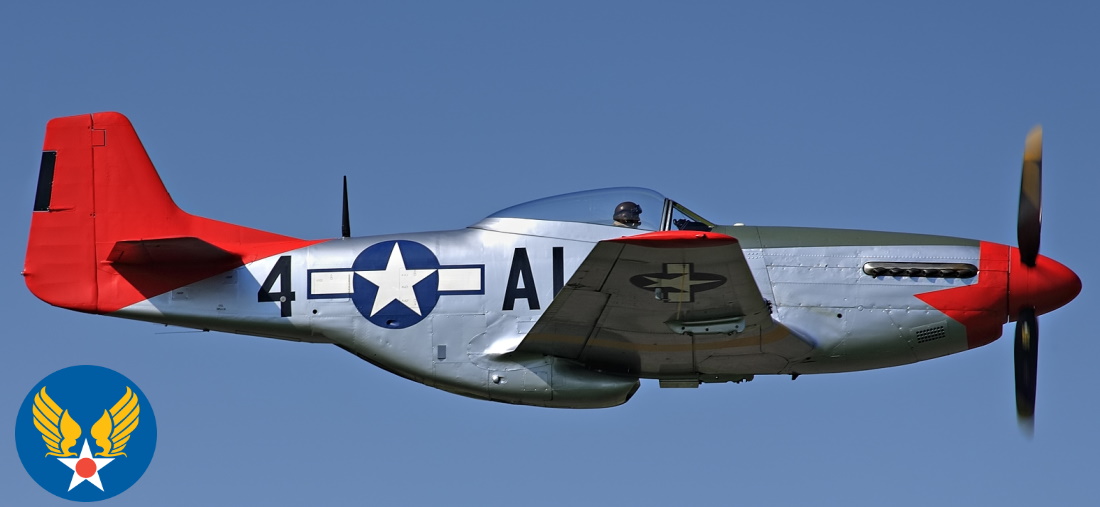Beginning its second week in action, the Command on August 8 struck a new high peal: of activity by flying 717 sorties. Five enemy aircraft were destroyed and 11 of our planes were lost. Strafing and dropping 94 tons of bombs, the XIX TAC fighter-bombers destroyed 29 locomotives 137 freight cars, 195 motor vehicles, 10 fuel and ammunition vehicles, 15 horse-drawn vehicles, and 11 flak positions; damaged 2 locomotives, 57 freight cars, 28 MT, and 26 armored vehicles; cut rail lines at 7 points, and attacked a troop concentration and 5 fuel dumps, one of which was completely destroyed.
Recce planes flew 46 tactical, 1 photographic, and 6 artillery recon missions. The outstanding features of the day’s operations were the large bag of enemy transport destroyed and damaged, and the almost continuous air cover provided to our ground forces. Improved communications with the 67th Recon Group facilitated the flow of information to the Army G-2 Section, and in several instances, information of enemy MT and tank concentrations was received in sufficient time to permit A-3 to order a mission.
A tremendous day, was the Army G-3 (Air) verdict, particularly in the number of MT destroyed. Attacks of all ground forces were facilitated. Cooperation with the ground was increasingly close. One flight of P-51s reported circling Morlaix while ground troops drove the enemy out of town. Another observed 100-plus German vehicles trapped on a road north of Brest by US armor at each end of the road. The enemy was picking up our call signs and by calling himself ‘Grandchap Able’ (Gen Ernest’s Task Force) or ‘Eggcup’ (4-AD), he was trying to send our planes into traps or on wild goose chases, but the transparent trick usually failed to work. He was clumsy, unfamiliar with our terms, and of course could not authenticate. Results were being obtained by our pilots regardless of cost. For example, the 362nd Group lost 4 P-47s on a 40 plane armed recon north and east of Paris in which they accomplished the following: Put 4 500-lb bombs on a gun position; guns were silenced; Dropped 2 frag clusters on another gun position with same results; Put 8 frag clusters and 2 500-PGP bombs on 40 boxcars; Destroyed 40 boxcars and a locomotive by dropping 4 frag clusters and 4 500-pounders on marshaling yard; Damaged 8 RR cars by dropping 8 250-pound frags on a second marshaling yard; Damaged 25 freight cars at another point; Dropped 2 frag clusters on an airdrome; Destroyed 7 MT and finally, Strafed 15 freight cars loaded with 155-mn guns.
 Later on their third group mission of the day the 362nd fire-eating fighter-bombers put 26 bombs on targets, claiming 3 destroyed, 4 damaged; 16 on a marshalling yard and hitting a workshop.
Later on their third group mission of the day the 362nd fire-eating fighter-bombers put 26 bombs on targets, claiming 3 destroyed, 4 damaged; 16 on a marshalling yard and hitting a workshop.
On the deck with their caliber .50 machine guns, they bagged two armored cars, two ammunition trucks, a gasoline truck, a dozen miscellaneous motor vehicles, and an enemy-operated jeep. As the Command moved up in the wake of the Army, it found the roads everywhere littered with the rusting wreckage of trucks, half-tracks, tanks, and guns knocked out by our planes and US Artillery. Not only the enemy’s vehicles but the fuel to run them was going up in smoke. On this same day, for instance, the 373rd Group, on armed recon over the ‘Orléans Gap’ between Paris and the Loire River, reported: 34 bombs in fuel dump. Totally destroyed. On another mission in the same area, this group spotted thirty freight cars, mostly oil tankers, entering a marshaling yard in which were fifty more cars. Results: 8 direct hits, 6 near misses, 6 heavy black smoke fires, 25 cars destroyed, and 50 damaged. For good measure, the cars were also strafed. The boys were pouring it on.
 Before they went home for more bombs and gas, these 32 P-47 pilots put eight 500-pounders on a train, destroying the locomotive and 3 cars and cutting the tracks; dropped 8 more on 25 rail-road cars in a marshaling yard, destroying 10 and damaging 10; and cut tracks in 3 different places. The enemy’s air had no success in trying to break up this disastrous wrecking of road and rail traffic. While the 405th Group was destroying some 60 motor vehicles and 8 freight cars, 3 Me-109s bounced a flight of its P-47s. Only 1 of the 3 German fighters escaped. Increasingly, the enemy began operating in groups of 20 to 40 or more and attacking only when he could obtain surprise and local superiority in numbers. His fighters on the excellent fields around Paris were being forced to fight in defense of their bases. Our fighter bombers were overhead daily now, on armed recces far ahead of the battlefront. One such mission on this date extended to the Belgian border.
Before they went home for more bombs and gas, these 32 P-47 pilots put eight 500-pounders on a train, destroying the locomotive and 3 cars and cutting the tracks; dropped 8 more on 25 rail-road cars in a marshaling yard, destroying 10 and damaging 10; and cut tracks in 3 different places. The enemy’s air had no success in trying to break up this disastrous wrecking of road and rail traffic. While the 405th Group was destroying some 60 motor vehicles and 8 freight cars, 3 Me-109s bounced a flight of its P-47s. Only 1 of the 3 German fighters escaped. Increasingly, the enemy began operating in groups of 20 to 40 or more and attacking only when he could obtain surprise and local superiority in numbers. His fighters on the excellent fields around Paris were being forced to fight in defense of their bases. Our fighter bombers were overhead daily now, on armed recces far ahead of the battlefront. One such mission on this date extended to the Belgian border.

 The Germans, meanwhile, were making nightly attacks on the vital bridges all around Avranches. The 9-AAF interrogation of a German airman shot down on the night of Aug 7, indicated that in a desperate attempt to knockout the essential bridge at Pontauboult, south of Avranches, on Aug 4, the ES-293 radio-controlled glider bomb had been used for the first time against a land target. On Aug 7 another attempt was made with this bomb, which is normally used against shipping. Two of the bombers were hit by night fighters, and one provided the prisoner who yielded this information.
The Germans, meanwhile, were making nightly attacks on the vital bridges all around Avranches. The 9-AAF interrogation of a German airman shot down on the night of Aug 7, indicated that in a desperate attempt to knockout the essential bridge at Pontauboult, south of Avranches, on Aug 4, the ES-293 radio-controlled glider bomb had been used for the first time against a land target. On Aug 7 another attempt was made with this bomb, which is normally used against shipping. Two of the bombers were hit by night fighters, and one provided the prisoner who yielded this information.
AUGUST 09-1944
This was the busiest day since the XIX TAC became operational. There were more missions (72) and more sorties (780) than on any previous day. Probably more than 19 enemy planes were destroyed, our claims totaling 13-2-0 in the air and 6-0-2 on the ground. 9 of our planes and pilots were lost. All but 2 of the groups flew 3 missions. The 3 squadrons of the 363rd Group and the 405th and 406th Squadrons of the 371st Group flew 5 missions. These squadrons averaged 11 hours and 45 minutes in the air. The day’s outstanding victory was turned in by the 378th Squadron of the 362nd Group. While flying air cover for the XV Corps northeast of Le Mans, the P-47s encountered 12 Me-109s at 300 feet and destroyed seven. Continuing on 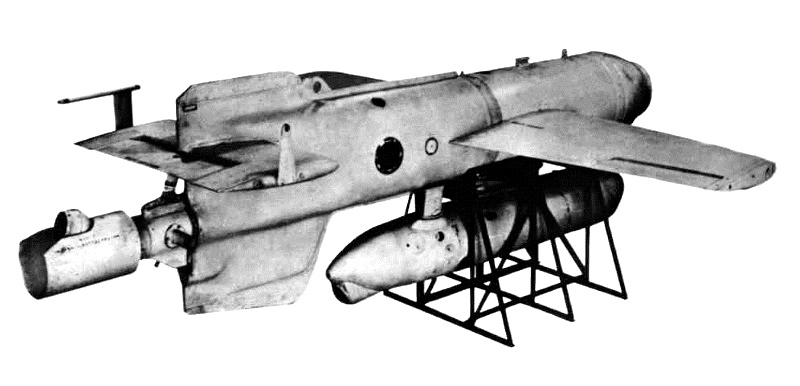 their mission, they destroyed 11 MT and 9 horse-drawn vehicles. A rocket squadron, the 513th of the 406th Group, was now in action, and 13 five-inch rockets were launched against ground targets, in addition to 58 tons of general-purpose bombs and numerous rounds of caliber .50 ammunition.
their mission, they destroyed 11 MT and 9 horse-drawn vehicles. A rocket squadron, the 513th of the 406th Group, was now in action, and 13 five-inch rockets were launched against ground targets, in addition to 58 tons of general-purpose bombs and numerous rounds of caliber .50 ammunition.
The swift advance was continuing. In mid-afternoon, the 358th Group reported wem>our troops and vehicles observed on the main road as far east as St Calais, and US troops seen fanning out from Le Man’s area east and south. Thirty-seven tactical and photographic reconnaissance sorties aided in keeping an eye on the enemy. Some of our squadrons on armored column cover were having difficulty in contacting ground control and consequently were missing opportunities for attacks.
One reported, for instance: EGGCUP (4-AD) assigned a target to the Squadron, but the ‘C’ Channel was so faint could not get enough information. All bombs returned to base. Another reported: Squadron given J-7608 as a target but would not authenticate, so no attack made.
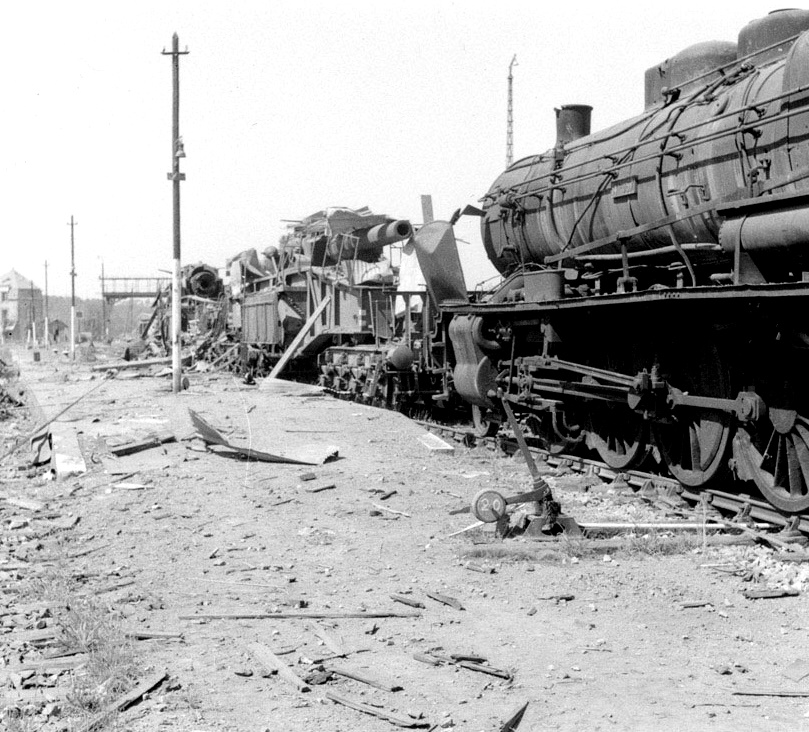 Still another said: All bombs returned. No contact with EGGCUP. When contact was established between tanks and planes, the story was entirely different, as these typical reports from groups operating on the Brittany Peninsula show: Targets assigned by EGGCUP. Two direct hits with 500-lb bombs on small buildings, completely destroyed, (Report from eight P-47s of the 371st Group).
Still another said: All bombs returned. No contact with EGGCUP. When contact was established between tanks and planes, the story was entirely different, as these typical reports from groups operating on the Brittany Peninsula show: Targets assigned by EGGCUP. Two direct hits with 500-lb bombs on small buildings, completely destroyed, (Report from eight P-47s of the 371st Group).
Contacted GRANDCHAP ABLE (Ernest Task Force) 100 plus horse-drawn carts loaded with troops on secondary road. Many troops and horses have been killed (Report from 8 strafing P-51s of the 363rd Group). “Vectored by GRANDCHAP ABLE to road. Destroyed 80 MT, and destroyed 25 horse-drawn vehicles. 200 troops killed. (Reported by 7 strafing P-51s of the 363rd Group).

 Under the pounding from ground and air, the enemy was beginning to wave the white flag. Reported eight more P-51s: Strafed column of 100-plus MD and animal-drawn vehicles. Continued until white flag was seen as our troops closed in on column from southwest, and, east, Planes covering the XV Corps troops advancing in the Le Man’s area were encountering enemy fighters. Vectored to enemy aircraft by 79-ID, reported 12 P-47s of the 362nd Gp: Two Me-109s observed 1000 at 700 feet altitude. One Me-109 was destroyed; one evaded combat. Losses: nones. Another squadron of the 362nd was bounced by 25 enemy fighters in the St Calais area east of Le Mans. Two Me-109s were destroyed for no loss, whereupon the enemy formation broke away and headed east.
Under the pounding from ground and air, the enemy was beginning to wave the white flag. Reported eight more P-51s: Strafed column of 100-plus MD and animal-drawn vehicles. Continued until white flag was seen as our troops closed in on column from southwest, and, east, Planes covering the XV Corps troops advancing in the Le Man’s area were encountering enemy fighters. Vectored to enemy aircraft by 79-ID, reported 12 P-47s of the 362nd Gp: Two Me-109s observed 1000 at 700 feet altitude. One Me-109 was destroyed; one evaded combat. Losses: nones. Another squadron of the 362nd was bounced by 25 enemy fighters in the St Calais area east of Le Mans. Two Me-109s were destroyed for no loss, whereupon the enemy formation broke away and headed east.
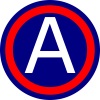 Third Army columns were now pushing into the big wasp nest of airbases between the Loire and the Seine, but enemy fighters were having little success in defending
Third Army columns were now pushing into the big wasp nest of airbases between the Loire and the Seine, but enemy fighters were having little success in defending  their home fields and were chiefly trying to get away. Reported 12 P-47s of the 362nd Gp: Squadron going south at 7000 feet saw 12 Me-109s going east at 300 feet. Shot down 7. Bombs were jettisoned for the fight, but afterward, the squadron went back to work against ground targets, its guns destroying 20 vehicles, most of which exploded. Almost all were going east, which the enemy seemed to consider the healthiest direction.
their home fields and were chiefly trying to get away. Reported 12 P-47s of the 362nd Gp: Squadron going south at 7000 feet saw 12 Me-109s going east at 300 feet. Shot down 7. Bombs were jettisoned for the fight, but afterward, the squadron went back to work against ground targets, its guns destroying 20 vehicles, most of which exploded. Almost all were going east, which the enemy seemed to consider the healthiest direction.
Far-ranging P-51s of the 354th Group, on armed recon beyond Paris, sighted 30-plus Ju-88s on Reims-Champagne Airfield and flew almost down the muzzles of its guns to strafe the field from 6000 feet to deck. Six Ju-88s were claimed as destroyed and two were probably destroyed. Two light guns and a flak tower were knocked out and one P-51 was lost to flak. In the Alençon area, 34 P-47s of the 373rd Group encountered 25 to 30 single-engine fighters and claimed 3-2-0 for no loss.
AUGUST 10-1944
Operations on August 10, were somewhat reduced by low stratus clouds moving in from the Channel late in the afternoon. Nevertheless, 54 missions comprising 659 sorties were flown. 46.2 tons of HE Bombs were dropped on targets and 4 enemy planes were shot down. Six of our aircraft and pilots were lost. The main weight of the day’s attack fell on railroad targets with claims of 12 locomotives and 254 cars destroyed or damaged. Other results included 22 tanks and other armored vehicles, 91 MT, 2 horse-drawn vehicles, and 5 bridges destroyed or damaged. Seven gun positions, a radar installation, a troop concentration, an ammunition dump, and a marshaling yard were attacked and seven rail lines were cut. With the 3-A elements striking his rear, the enemy now has swung about in the Alençon–Argentan area and his tanks and artillery were engaging our troops attacking northward from Le Mans. As a result, our fighter-bombers found many good targets for their bombs and guns.
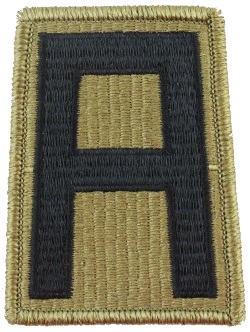
 Sometimes a single bomb or strafing pass wiped out considerable firepower. Reported by eight P-47s of the 371st Gp: one bomb on 25 horse-drawn artillery pieces and 100 troops, then strafed. Many soldiers and horses were killed Nobody likes to kill horses, but these were pulling guns. Our planes operating in the area of the boundary between the 1-A and the 3-A occasionally got emergency requests from 1-A Units needing help. Reported from the 362nd Group: ‘14 500-pound bombs on mortar position at T-6413. Target
Sometimes a single bomb or strafing pass wiped out considerable firepower. Reported by eight P-47s of the 371st Gp: one bomb on 25 horse-drawn artillery pieces and 100 troops, then strafed. Many soldiers and horses were killed Nobody likes to kill horses, but these were pulling guns. Our planes operating in the area of the boundary between the 1-A and the 3-A occasionally got emergency requests from 1-A Units needing help. Reported from the 362nd Group: ‘14 500-pound bombs on mortar position at T-6413. Target  assigned by Murphy (CCB, 2-AD, 1-A). Position destroyed. Four aircraft also started this position. A similar report came from the 371st Group: Seven 500-pound bombs on gun position T-6712. The area was marked with smoke and bombed accurately. No results were observed. Murphy reported guns silenced.
assigned by Murphy (CCB, 2-AD, 1-A). Position destroyed. Four aircraft also started this position. A similar report came from the 371st Group: Seven 500-pound bombs on gun position T-6712. The area was marked with smoke and bombed accurately. No results were observed. Murphy reported guns silenced.
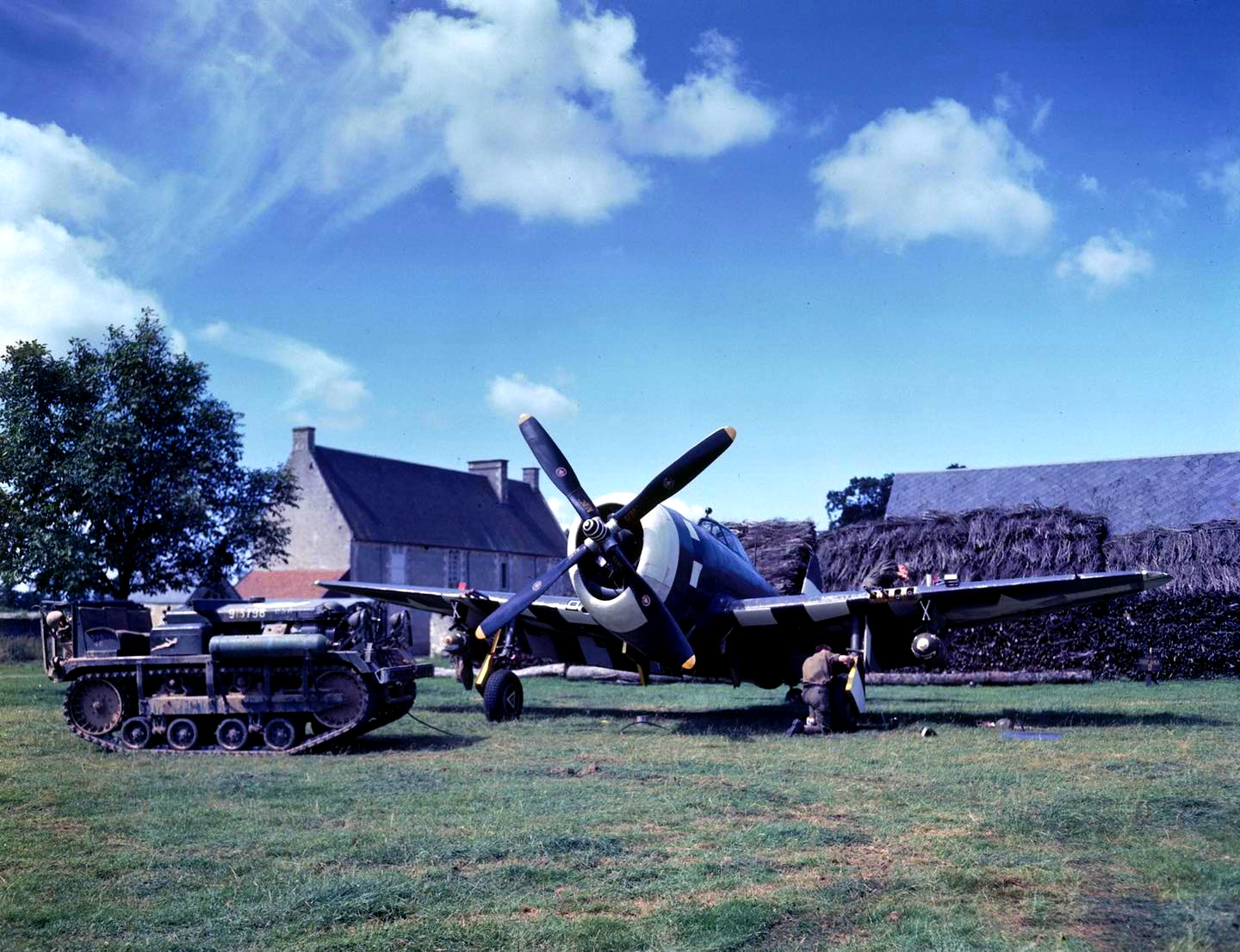 Forty-two railroad cars and a flak battery were knocked out at the Lorient marshaling yard, when eight P-47s of the 36th Group dive-bombed the yard in the teeth of intense, accurate heavy, and light flak after receiving 4-AD’s OK. All returned, though one was badly damaged by the flak over this heavily defended submarine base town. Wide-sweeping railroad recces north, east, and south of Paris to isolate the eastern battlefield were likewise bearing fruit. Near Montargis, southeast of Paris, 12 P-47s of the 510th Sq (405th Group), twice strafed a loaded troop train consisting of 25 large personnel cars. The troops detrained with alacrity, but casualties were believed high. On the same
Forty-two railroad cars and a flak battery were knocked out at the Lorient marshaling yard, when eight P-47s of the 36th Group dive-bombed the yard in the teeth of intense, accurate heavy, and light flak after receiving 4-AD’s OK. All returned, though one was badly damaged by the flak over this heavily defended submarine base town. Wide-sweeping railroad recces north, east, and south of Paris to isolate the eastern battlefield were likewise bearing fruit. Near Montargis, southeast of Paris, 12 P-47s of the 510th Sq (405th Group), twice strafed a loaded troop train consisting of 25 large personnel cars. The troops detrained with alacrity, but casualties were believed high. On the same  mission these twelve planes destroyed a 30-car train by bombing and strafing, blew up three other cars and fired two oil cars. One plane was destroyed by flak, but the pilot was saved.
mission these twelve planes destroyed a 30-car train by bombing and strafing, blew up three other cars and fired two oil cars. One plane was destroyed by flak, but the pilot was saved.
Observations by our pilots over the battle areas gave a running record of events, in addition to spotting enemy movements, gun positions, and other targets: US troop convoy on all approaches to Nantes. Fire and smoke in Nantes; St Malo harbor covered by smoke; Observed US troops in red-paneled vehicles in Mortain at 1500 hours; Head of Allied tank column seen at point 8 to 10 miles southwest of Bonnetable. Thirty sorties-were flown by our tactical recon P-51s, operating chiefly over areas on the outer fringe of operations. These two-plane patrols contributed considerably to the most effective use of the available air-power, since fighter-bombers could be quickly vectored to any important targets spotted and thus less time was wasted in uneventful armed recces. Two artillery recon and two photographic recon sorties were flown. These types of recce were being employed chiefly in connection with the continuing attacks on the stubborn Brittany ports.
These two-plane patrols contributed considerably to the most effective use of the available air-power, since fighter-bombers could be quickly vectored to any important targets spotted and thus less time was wasted in uneventful armed recces. Two artillery recon and two photographic recon sorties were flown. These types of recce were being employed chiefly in connection with the continuing attacks on the stubborn Brittany ports.
 At St Malo, bitter resistance was being encountered, and the day’s specific air support requests included calls for medium bomber assistance in reducing the town’s Citadel, the coastal defense on the Ile de Cezembre, and other heavy batteries controlling the harbor. These requests were transmitted to 9-AAF and the targets were subsequently attacked. Meanwhile, the XIX TAC fighter-bombers continued the assault on this strongly flak-defended area to the limit of the abilities of this type of aircraft. The Ile de Cezembre (Cezembre Island) was made a standard last-resort target and dumping ground for planes forced to jettison their bombs, yet at the end of the month the Germans still doggedly held out there.
At St Malo, bitter resistance was being encountered, and the day’s specific air support requests included calls for medium bomber assistance in reducing the town’s Citadel, the coastal defense on the Ile de Cezembre, and other heavy batteries controlling the harbor. These requests were transmitted to 9-AAF and the targets were subsequently attacked. Meanwhile, the XIX TAC fighter-bombers continued the assault on this strongly flak-defended area to the limit of the abilities of this type of aircraft. The Ile de Cezembre (Cezembre Island) was made a standard last-resort target and dumping ground for planes forced to jettison their bombs, yet at the end of the month the Germans still doggedly held out there.
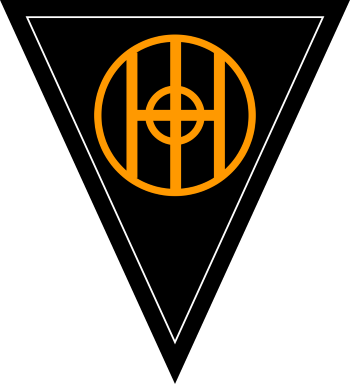 On several occasions, emissaries from 83-ID visited the island by boat under truce and demanded surrender, only to be told that the Commander had orders from Der Fuehrer not to give up and would obey them. Brest’s far more powerful defenses likewise were obviously beyond the ability of fighter-bombers to crack, and requests for assistance by heavy and medium bombers were transmitted to higher headquarters. Throughout the month, attacks of increasing violence were made by aircraft of all types in cooperation with 3-A troops assaulting this badly needed port, yet September was to find its garrison still holding out.
On several occasions, emissaries from 83-ID visited the island by boat under truce and demanded surrender, only to be told that the Commander had orders from Der Fuehrer not to give up and would obey them. Brest’s far more powerful defenses likewise were obviously beyond the ability of fighter-bombers to crack, and requests for assistance by heavy and medium bombers were transmitted to higher headquarters. Throughout the month, attacks of increasing violence were made by aircraft of all types in cooperation with 3-A troops assaulting this badly needed port, yet September was to find its garrison still holding out.
One of the six casualties of this day was Col Morton David Magoffin, commanding the 362nd Group. Hit by flak while on a dive-bombing and strafing mission in support of XV Corps east of Le Mans, he continued to lead the squadron in its bombing run hoping that the dive would blow out fire in his engine. It failed to do so and he pulled up and bailed out. The sequel to this episode did not come to light until weeks later.
 Col Magoffin fell into enemy hands and was taken to hospital in Paris with a flak wound in his right thigh. When the enemy evacuated Paris he hid in a closet and escaped notice. French surgeons performed a badly needed operation and the Col was subsequently evacuated by air to England.
Col Magoffin fell into enemy hands and was taken to hospital in Paris with a flak wound in his right thigh. When the enemy evacuated Paris he hid in a closet and escaped notice. French surgeons performed a badly needed operation and the Col was subsequently evacuated by air to England.











